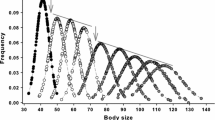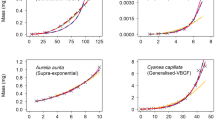Abstract
Compensatory growth refers to an animal’s ability to grow extremely rapidly after it has experienced a period of reduced growth. It is also widely held that the growth trajectories of animals showing compensatory growth converge towards those followed by conspecifics that have experienced favorable growth conditions throughout their lives. In other words, it is often assumed that animals undergoing compensatory growth also show some recovery, and thereby exhibit catch-up growth. This belief has resulted in the terms compensatory growth, recovery growth, and catch-up growth being used as synonyms, and has also created some problems with regard to data analysis and interpretation. Following a discussion of methods of analysis and their limitations, a series of growth simulations is presented to illustrate why the terms should not be used as synonyms. The simulations, based upon the assumption that compensatory growth results in a restoration of body composition (using condition index as a surrogate), show that compensatory growth is not always accompanied by a convergence of growth trajectories. Compensatory growth can occur in the absence of catch-up growth, and the simultaneous observation of compensatory growth and a recovery of body mass is a special combination of events. Further, it is possible for growth trajectories to converge even when animals that have experienced a period of reduced growth do not display compensatory growth. Definitions are proposed that distinguish between the terms compensatory growth, recovery growth, and catch-up growth, and guidelines are given relating to the analysis of the results of fish compensatory growth studies.



Similar content being viewed by others
References
Ali M, Nicieza A, Wootton RJ (2003) Compensatory growth in fishes: a response to growth depression. Fish Fish 4:147–190. doi:10.1046/j.1467-2979.2003.00120.x
Alvarez D, Nicieza A (2005) Compensatory response ‘defends’ energy levels but not growth trajectories in brown trout, Salmo trutta L. Proc R Soc Lond B Biol Sci 272:601–607. doi:10.1098/rspb.2004.2991
Brett JR (1979) Environmental factors and growth. In: Hoar WS, Randall DJ, Brett JR (eds) Fish physiology, vol 8. Academic Press, New York, pp 599–675
Broeckhuizen N, Gurney WSC, Jones A, Bryant AD (1994) Modelling compensatory growth. Funct Ecol 8:770–782. doi:10.2307/2390237
Charnov EL (2008) Fish growth: Bertalanffy k is proportional to reproductive effort. Environ Biol Fishes 83:185–187. doi:10.1007/s10641-007-9315-5
Cho CY (1992) Feeding systems for rainbow trout and other salmonids with reference to current estimates of energy and protein requirements. Aquaculture 100:107–123. doi:10.1016/0044-8486(92)90353-M
Forbes GB (2002) Perspectives on body composition. Curr Opin Clin Nutr Metab Care 5:25–30. doi:10.1097/00075197-200201000-00005
Fu C, Li D, Hu W, Wang Y, Zhu Z (2007) Fast-growing transgenic common carp mounting compensatory growth. J Fish Biol 71(Supplement B):174–185. doi:10.1111/j.1095-8649.2007.01401.x
Gauthier C, Campbell PGC, Couture P (2008) Physiological correlates of growth and condition in the yellow perch (Perca flavescens). Comp Biochem Physiol 151A:526–532
Harris RBS, Kasser TR, Martin RJ (1986) Dynamics of recovery of body composition after overfeeding, food restriction or starvation of mature female rats. J Nutr 116:2536–2546
Hornick JL, Van Eenaeme C, Gérard O, Dufrasne I, Istasse L (2000) Mechanisms of reduced and compensatory growth. Domest Anim Endocrinol 19:121–132. doi:10.1016/S0739-7240(00)00072-2
Iwama GK (1996) Growth of salmonids. In: Pennell W, Barton BA (eds) Principles of salmonid culture. Elsevier, Amsterdam, pp 467–515
Iwama GK, Tautz AF (1981) A simple growth model for salmonids in hatcheries. Can J Fish Aquat Sci 38:649–656. doi:10.1139/f81-087
Jobling M (1994) Fish bioenergetics. Chapman and Hall, London
Jobling M, Johansen SJS (1999) The lipostat, hyperphagia and catch-up growth. Aquacult Res 30:473–478. doi:10.1046/j.1365-2109.1999.00358.x
Jobling M, Jørgensen EH, Siikavuopio SI (1993) The influence of previous feeding regime on the compensatory growth response of maturing and immature Arctic charr, Salvelinus alpinus. J Fish Biol 43:409–419. doi:10.1111/j.1095-8649.1993.tb00576.x
Jobling M, Meløy OH, dos Santos J, Christiansen B (1994) The compensatory growth response of the Atlantic cod: effects of nutritional history. Aquacult Int 2:75–90. doi:10.1007/BF00128802
Johansen SJS, Ekli M, Stangnes B, Jobling M (2001) Weight gain and lipid deposition in Atlantic salmon, Salmo salar, during compensatory growth: evidence for lipostatic regulation? Aquacult Res 32:963–974. doi:10.1046/j.1365-2109.2001.00632.x
Johnsson JI, Bohlin T (2005) Compensatory growth for free? A field experiment on brown trout, Salmo trutta. Oikos 111:31–38. doi:10.1111/j.0030-1299.2005.13972.x
Lambert Y, Dutil J-D (1997) Can simple condition indices be used to monitor and quantify seasonal changes in the energy reserves of Atlantic cod (Gadus morhua). Can J Fish Aquat Sci 54(Supplement 1):104–112. doi:10.1139/cjfas-54-S1-104
Martinez-Ramirez HR, Jeaurond EA, de Lange CFM (2009) Nutrition-induced differences in body composition, compensatory growth and endocrine status in growing pigs. Animal 3:228–236. doi:10.1017/S1751731108003492
Mitchell AD (2007) Impact of research with cattle, pigs, and sheep on nutritional concepts: body composition and growth. J Nutr 137:711–714
Montserrat N, Gabillard JC, Capilla E, Navarro MI, Gutierrez J (2007) Role of insulin, insulin-like growth factors, and muscle regulatory factors in the compensatory growth of trout (Oncorhynchus mykiss). Gen Comp Endocrinol 150:462–472. doi:10.1016/j.ygcen.2006.11.009
Nicieza AG, Alvarez D (2009) Statistical analysis of structural compensatory growth: how can we reduce the rate of false detection? Oecologia 159:27–39. doi:10.1007/s00442-008-1194-8
Oh S-Y, Noh CH, Kang R-S, Kim C-K, Cho SH, Jo J-Y (2008) Compensatory growth and body composition of juvenile black rockfish Sebastes schlegeli following feed deprivation. Fish Sci 74:846–852. doi:10.1111/j.1444-2906.2008.01598.x
Pangle KL, Sutton TM (2005) Temporal changes in the relationship between condition indices and proximate composition of juvenile Coregonus artedi. J Fish Biol 66:1060–1072. doi:10.1111/j.0022-1112.2005.00660.x
Picha ME, Turano MJ, Tipsmark CK, Borski RJ (2008) Regulation of endocrine and paracrine sources of Igfs and Gh receptor during compensatory growth in hybrid striped bass (Morone chrysops × Morone saxatilis). J Endocrinol 199:81–94. doi:10.1677/JOE-07-0649
Rennie MD, Verdon R (2008) Development and evaluation of condition indices for the lake whitefish. N Am J Fish Manag 28:1270–1293. doi:10.1577/M06-258.1
Rescan P-Y, Montfort J, Rallière C, Le Cam A, Esquerré D, Hugot K (2007) Dynamic gene expression in fish muscle during recovery growth induced by a fasting-refeeding schedule. BMC Genomics 8:438
Ricker WE (1979) Growth rates and models. In: Hoar WS, Randall DJ, Brett JR (eds) Fish physiology, vol 8. Academic Press, New York, pp 677–743
Rueda FM, Martinez FJ, Zamora S, Kentouri M, Divanach P (1998) Effect of fasting and refeeding on growth and body composition of red porgy, Pagrus pagrus L. Aquacult Res 29:447–452
Skalski GT, Picha ME, Gilliam JF, Borski RJ (2005) Variable intake, compensatory growth, and increased growth efficiency in fish: models and mechanisms. Ecology 86:1452–1462. doi:10.1890/04-0896
Sutton SG, Bult TP, Haedrich RL (2000) Relationships among fat weight, body weight, water weight, and condition factors in wild Atlantic salmon parr. Trans Am Fish Soc 129:527–538. doi:10.1577/1548-8659(2000)129<0527:RAFWBW>2.0.CO;2
Turano MJ, Borski RJ, Daniels HV (2008) Effects of cyclic feeding on compensatory growth of hybrid striped bass (Morone chrysops × M. saxitilis) foodfish and water quality in production ponds. Aquacult Res 39:1514–1523. doi:10.1111/j.1365-2109.2008.02023.x
Wang Y, Cui Y, Yang Y, Cai F (2000) Compensatory growth in hybrid tilapia, Oreochromis mossambicus × O. niloticus, reared in seawater. Aquaculture 189:101–108. doi:10.1016/S0044-8486(00)00353-7
Weatherley AH, Gill HS (1987) The biology of fish growth. Academic Press, London
Wright IA, Russel AJF (1991) Changes in the body composition of beef cattle during compensatory growth. Anim Prod 52:105–113
Author information
Authors and Affiliations
Corresponding author
Rights and permissions
About this article
Cite this article
Jobling, M. Are compensatory growth and catch-up growth two sides of the same coin?. Aquacult Int 18, 501–510 (2010). https://doi.org/10.1007/s10499-009-9260-8
Received:
Accepted:
Published:
Issue Date:
DOI: https://doi.org/10.1007/s10499-009-9260-8




